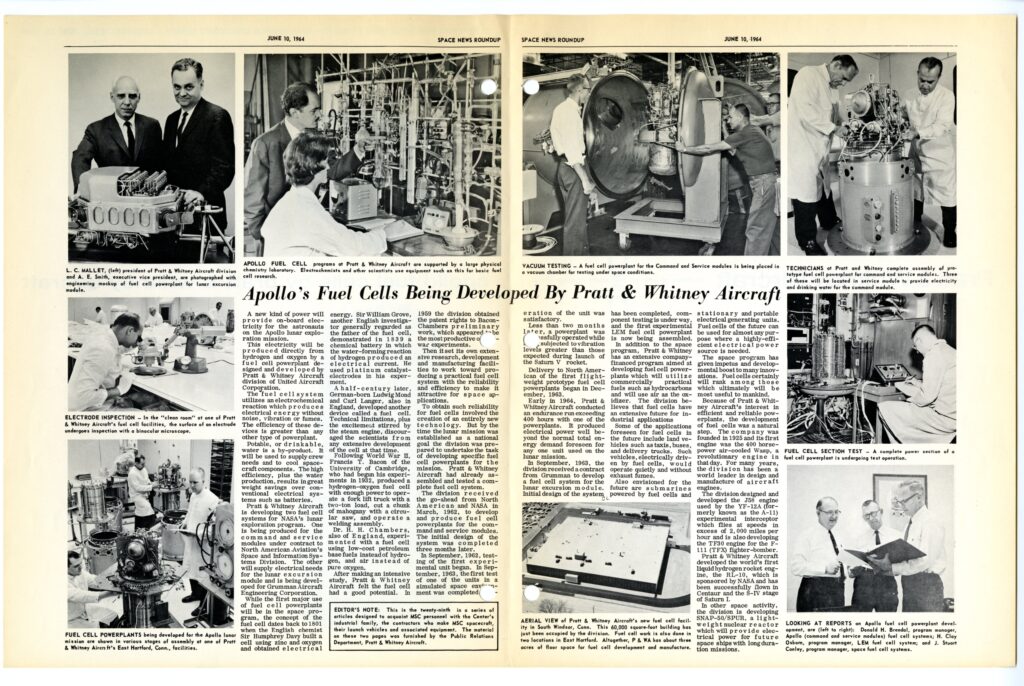By Ria Saxena and Jessica Vogelgesang
The year was 1962. Gazing with wonder into the depths of the universe had become a new national pastime. The stars, the moon, and the entire galaxy seemed as far away from South Windsor, Connecticut, as the goal of putting a human in space. Meanwhile, on Governor’s Highway, halfway between Route 5 and Old Main Street, a group of Pratt & Whitney Aircraft (PWA) engineers devoted their time to reaching space. Partnering with the National Aeronautics and Space Administration (NASA), members of PWA’s Advanced Power Systems department took on the task of developing fuel cell power generators for the Apollo missions. This fascinating story unfolded in our own backyard.
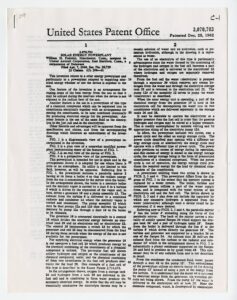 A fuel cell is an energy source used to convert hydrogen and oxygen into electricity. Unlike power sources such as oil or gas that produce carbon dioxide, fuel cells generate electricity with heat and drinkable water as their only byproducts. In the 1960s, the fuel cell concept was not entirely new. According to the June 10, 1964, issue of Space News Roundup, Sir William Grove made the first fuel cell design in 1839, and later, in 1930, Francis Thomas Bacon refined the concept. “The fuel cell system utilizes an electrochemical reaction which produces electrical energy without noise, vibration, or fumes. The efficiency of these devices is greater than any other type of powerplant,” Space News reported. “The high efficiency, plus the water production, results in greater weight savings over conventional electrical systems such as batteries.” Because of these advantages, when seeking a power source for its long-term missions, NASA eventually looked to fuel cells and chose Pratt & Whitney Aircraft to develop them.
A fuel cell is an energy source used to convert hydrogen and oxygen into electricity. Unlike power sources such as oil or gas that produce carbon dioxide, fuel cells generate electricity with heat and drinkable water as their only byproducts. In the 1960s, the fuel cell concept was not entirely new. According to the June 10, 1964, issue of Space News Roundup, Sir William Grove made the first fuel cell design in 1839, and later, in 1930, Francis Thomas Bacon refined the concept. “The fuel cell system utilizes an electrochemical reaction which produces electrical energy without noise, vibration, or fumes. The efficiency of these devices is greater than any other type of powerplant,” Space News reported. “The high efficiency, plus the water production, results in greater weight savings over conventional electrical systems such as batteries.” Because of these advantages, when seeking a power source for its long-term missions, NASA eventually looked to fuel cells and chose Pratt & Whitney Aircraft to develop them.
Technological Emergence
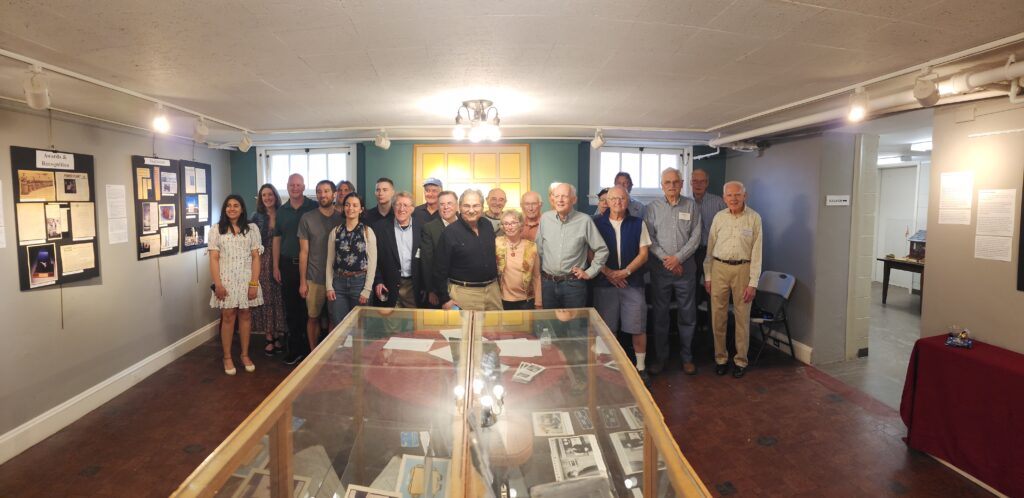 In 1959, Pratt & Whitney, a division of United Aircraft Corporation (UAC), announced that it would partner with the Patterson-Moos division of the Universal Winding Company (later renamed Leesona) to produce a fuel cell. Under the agreement, Patterson-Moos continued its research program in fuel technology while PWA worked on developing fuel cell systems and system components. PWA started the project by buying the patent rights to the fuel cell research Francis T. Bacon and H. H. Chambers had begun in the United Kingdom a century earlier.
In 1959, Pratt & Whitney, a division of United Aircraft Corporation (UAC), announced that it would partner with the Patterson-Moos division of the Universal Winding Company (later renamed Leesona) to produce a fuel cell. Under the agreement, Patterson-Moos continued its research program in fuel technology while PWA worked on developing fuel cell systems and system components. PWA started the project by buying the patent rights to the fuel cell research Francis T. Bacon and H. H. Chambers had begun in the United Kingdom a century earlier.
In 1962, President John F. Kennedy declared, “We choose to go to the moon in this decade and do the other things, not because they are easy, but because they are hard.” His speech was a public declaration of the country’s commitment to the Space Race. That same year, NASA awarded one of two multimillion-dollar contracts to UAC’s PWA division in East Hartford. Within three years, PWA had selected a group of engineers to develop and produce fuel cells for NASA’s Command and Service Module, the part of the spacecraft that would carry the astronauts through space. The team moved into the newly constructed South Windsor Engineering Facility plant on Governor’s Highway.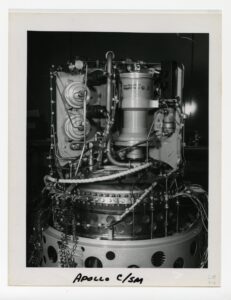
The cohort of fuel cell experts and hardware engineers at PWA began their collaboration with the lofty goal of reaching the moon. After a year of interpreting Bacon’s designs and adapting the original work, the team created a prototype in 1963. This model was then tested by North American Aviation, an aerospace manufacturer, and it passed with flying colors. In 1964, PWA conducted another successful test on a prototype, confirming the fuel cell’s suitability for moon travel and achieving a milestone in the Apollo program.
Continued tests monitored the fuel cell’s performance for 400 hours and then 1,000 hours. As stated in a March 22, 1965, Missiles and Rockets article, these experiments found that the fuel cells lasted more than twice the planned length of the first lunar mission. Success, it seemed, followed the fuel cell. As a result, PWA was subcontracted to build fuel cells as a power source for the Apollo Lunar Excursion Module (LEM), the shuttle component that would land the astronauts on the moon and return them to the Command and Service Module (CSM).
Mild Turbulence
Enthusiasm for fuel cells went beyond the Apollo program. At the time, Nickelsworth Magazine reported that “many scientists believe [the fuel cell]will take its place alongside atomic energy in revolutionizing power production.” This hope proved to be short-lived regarding the Lunar Excursion Module project, however, as more and more engineers and aerospace executives began to weigh the additional development costs of having a relatively new and immature technology used in place of reliable batteries. In March 1965, conventional batteries replaced the fuel cells planned for the LEM, and NASA made cutbacks in the production of fuel cells for Apollo’s LEM. All parties agreed that fuel cells would still be used for the Command and Service Module.
Awards and Recognition
Despite the setback, the South Windsor Engineering Facility doubled in size after the discontinuation of the LEM program. Pratt & Whitney’s fuel cell work continued to receive praise. The company was awarded the prestigious United Aircraft Corporation Board of Directors trophy for Outstanding Engineering Achievement for its work in fuel cells. At the same time, the US Department of Defense (DOD) offered substantial funding for the Apollo and Gemini missions into 1966, as outlined in a PWA budget report. The financial support from the DOD was largely due to each program’s success in using fuel cells for generating onboard power and drinking water. Recognition continued as the PC-3, a fuel cell developed in South Windsor, completed the first phase of its rigid qualification test.
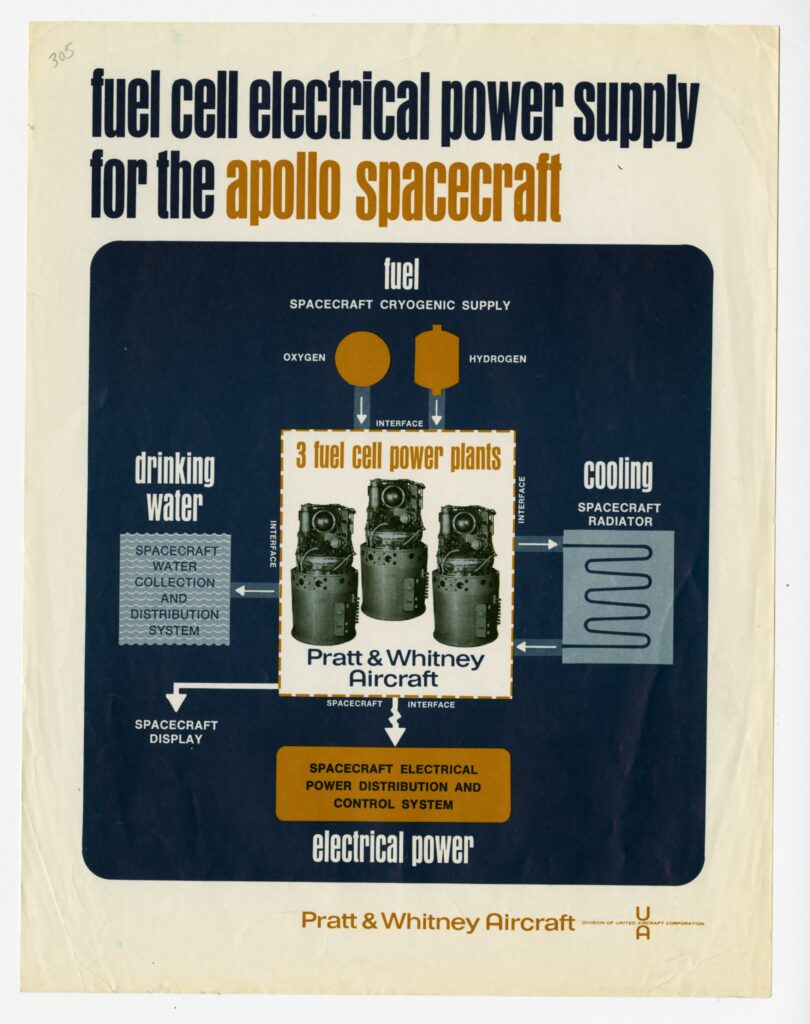 By April 1966, after undergoing 21,000 accumulated hours of endurance testing at the facility in South Windsor, fuel cells were installed in the Apollo spacecraft, which was then delivered to NASA’s Space and Information Systems for a scheduled uncrewed test flight. By July 1966, the fuel cells had passed integrity testing and were installed in NASA’s 011 spacecraft, which was then launched to gather final module heat shield information and determine if the technology was ready for human-crewed missions. As The Hartford Courant reported on August 26, 1966, astronauts Gus Grissom, Ed White, and Roger B. Chaffee, who were slated to be the first men on the moon, observed this perfectly executed mission. NASA intended to have the men in orbit by Christmas 1967. But then disaster struck: on January 27, 1967, during an Apollo 1 CSM 012 launch pad test, a fire killed all three astronauts.
By April 1966, after undergoing 21,000 accumulated hours of endurance testing at the facility in South Windsor, fuel cells were installed in the Apollo spacecraft, which was then delivered to NASA’s Space and Information Systems for a scheduled uncrewed test flight. By July 1966, the fuel cells had passed integrity testing and were installed in NASA’s 011 spacecraft, which was then launched to gather final module heat shield information and determine if the technology was ready for human-crewed missions. As The Hartford Courant reported on August 26, 1966, astronauts Gus Grissom, Ed White, and Roger B. Chaffee, who were slated to be the first men on the moon, observed this perfectly executed mission. NASA intended to have the men in orbit by Christmas 1967. But then disaster struck: on January 27, 1967, during an Apollo 1 CSM 012 launch pad test, a fire killed all three astronauts.
Final Stretch
After this tragedy, NASA internal reports found that poor technical design—unrelated to the fuel cells—was to blame. As a result, subsequent Apollo 1 progress slowed, yet three successful test launches put the program back on track later in the year. Apollo 4 was finally launched on November 9, 1967. Clearing this hurdle ensured the viability of the Apollo program and PWA fuel cell technology in space. Indeed, fuel cells were such an integral part of the spacecraft that most of the Apollo missions during this stretch had a specific testing goal for the technology: Apollo 2 featured the first test of fuel cells in Apollo flight; Apollo 4 measured fuel cell performance in zero gravity; Apollo 6 showed fuel cell load-sharing ability and situational adaptability; Apollo 7 established a record number of operating hours for fuel cells in space flight; and Apollo 8 demonstrated fuel cell reliability and translunar flight precision.
Each mission was more successful than the last, culminating in the crewed Apollo 7, 8, 9, and 10 missions. Finally, in July 1969, after years of hard work and sacrifice, the Apollo 11 Command and Service Module, powered by South Windsor’s Pratt & Whitney fuel cells and providing all the astronauts’ drinking water, carried man to the moon.
Lasting Legacy
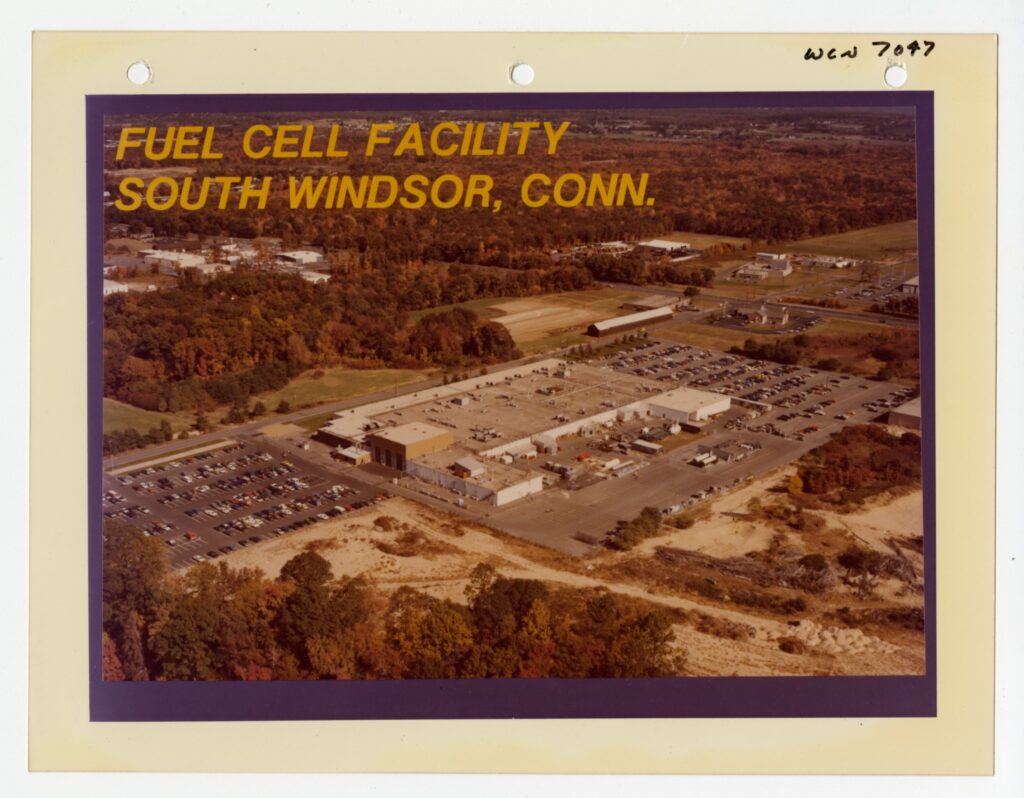 The unparalleled success of the PC-3 fuel cell in the Apollo program earned it high praise from the engineering community; in 1970, Design Engineering Magazine declared that “the fuel cell may eventually become the greatest development since sliced bread.” Its role in the Apollo program also led to the funding of other fuel cell programs, most notably the Deep Sea Vehicle (DSV). Using the PC-15, a newly developed fuel cell, the DSV was designed to reach depths of 20,000 feet. This was followed by the PC-17, which powered the space shuttle on 135 missions.
The unparalleled success of the PC-3 fuel cell in the Apollo program earned it high praise from the engineering community; in 1970, Design Engineering Magazine declared that “the fuel cell may eventually become the greatest development since sliced bread.” Its role in the Apollo program also led to the funding of other fuel cell programs, most notably the Deep Sea Vehicle (DSV). Using the PC-15, a newly developed fuel cell, the DSV was designed to reach depths of 20,000 feet. This was followed by the PC-17, which powered the space shuttle on 135 missions.
The fuel cell program spearheaded by Pratt & Whitney Aircraft represents the best of human ingenuity. The fuel cells the team developed in South Windsor were an essential component of the Apollo Command and Service Module, which became the pride of the nation when it delivered the Apollo 11 astronauts to the moon. The fuel cell remains significant today due to its multiple clean energy applications.
Ria Saxena is a first-year student at George Washington University. During her senior year at South Windsor High School, she researched and curated the exhibit The Local History of Fuel Cells: How South Windsor Engineers Got NASA to the Moon.
Jessica Vogelgesang is the communications director for the Friends of Wood Memorial Library and Museum and the author of a weekly educational email series, Musings from Main, available at WoodMemorialLibrary.org.
Learn More!
Examine local business records in the Wood Memorial Library and Museum’s archives, featuring the Joseph A. Bost Collection of UTC Fuel Cell Papers as well as documents and objects donated by Vicky and Paul Margiott, Henry Cote, Ted Koch, and Tom Gilmartin. Learn more at WoodMemorialLibrary.org.

